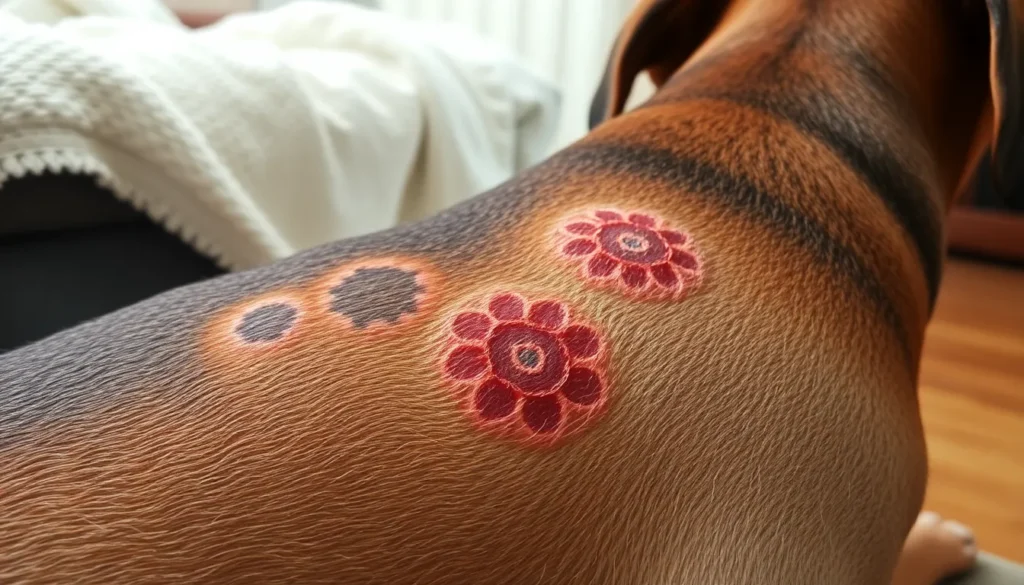When it comes to pets, nothing’s more adorable than a dog wagging its tail. But what if that tail’s hiding a little trouble? Ringworm might sound like a funky dance move, but it’s actually a pesky skin infection that can leave your furry friend looking less than fabulous. If you’ve noticed some weird patches on your pup, you’re in the right place.
Table of Contents
ToggleUnderstanding Ringworm in Dogs
Ringworm is a fungal infection that affects the skin, hair, and nails of dogs. This condition, caused by dermatophyte fungi, can result in hair loss and irritating skin lesions.
What Is Ringworm?
Ringworm, despite its name, is not a worm. It’s a skin infection caused by various types of fungi. Common symptoms include circular patches of hair loss and redness on the skin. The fungus thrives in warm, moist environments and can spread easily between animals and humans. Diagnosis often involves examining skin scrapings under a microscope or through a fungal culture. Identifying ringworm quickly is important to initiate proper treatment.
How Does Ringworm Affect Dogs?
Ringworm affects dogs by causing uncomfortable skin lesions. The infection leads to bald patches that may appear scaly or inflamed. Intense itching results, prompting dogs to scratch or bite the affected areas, which can worsen the condition. In severe cases, secondary bacterial infections may develop. Puppies, older dogs, and those with weakened immune systems are at higher risk. Immediate veterinary care is essential to manage symptoms and prevent further spread.
Identifying Ringworm

Identifying ringworm in dogs relies on recognizing specific symptoms and distinguishing it from other skin conditions. Early detection aids in effective treatment and minimizes spreading.
Common Symptoms of Ringworm
Common symptoms of ringworm include circular patches of hair loss. Skin lesions appear red and scaly, often causing inflammation. Severe itching often leads to scratching, resulting in further skin damage. Dogs may also develop a crusty appearance around the affected areas. Other signs include flaky skin and changes in coat texture. Immediate attention to these symptoms helps in managing the infection promptly.
How to Differentiate Ringworm from Other Skin Conditions
Differentiating ringworm from other skin conditions involves careful observation. Ringworm typically presents as round, bald patches, unlike other infections that may spread irregularly. Bacterial infections often lack the characteristic ring shape of ringworm. In contrast, allergies may lead to widespread itching but usually affect other areas without uniformity. Fungal infections usually produce more pronounced scales compared to non-fungal issues. Consulting a veterinarian for accurate diagnosis ensures proper treatment for the dog.
Photos of Ringworm on Dogs
Photos of ringworm on dogs can provide valuable visual insights into this skin infection. Recognizing its characteristics helps pet owners identify and address the issue promptly.
Visual Comparison of Healthy Skin vs. Infected Skin
Healthy skin appears smooth and vibrant, while infected skin shows distinct signs of ringworm. Affected areas often exhibit circular patches with hair loss, presenting a stark contrast to surrounding fur. Redness and flakiness accompany these patches, indicating irritation. Infected skin may also exhibit scabbing or dryness, further enhancing the visual differences. Observing these changes visually aids in understanding the severity of the infection.
Different Stages of Ringworm Infections
Different stages of ringworm infections showcase varying symptoms. Initially, one might notice small, round patches on the skin that gradually enlarge over time. As the infection progresses, lesions become more pronounced, often appearing crusty or scabbed. In advanced stages, fur may completely disappear from the affected area, leaving bare skin vulnerable. These changes indicate an increased need for veterinary intervention to halt the infection’s spread and promote healing. Observing these stages enables faster recognition and treatment of the infection.
Treatment Options for Ringworm
Effective treatment options for ringworm focus on eliminating the fungal infection and relieving symptoms. Both veterinary recommendations and home remedies offer pathways for managing this condition.
Veterinary Recommendations
Veterinarians often prescribe antifungal medications such as terbinafine or griseofulvin to treat ringworm. Dosage depends on the dog’s weight and severity of the infection. They may also recommend topical treatments, including antifungal creams or medicated shampoos, to apply directly on affected areas. Regular follow-up appointments ensure that the infection has cleared effectively. In some cases, a veterinary visit involves performing a fungal culture to confirm the diagnosis before beginning treatment.
Home Remedies and Care
While veterinary treatment is critical, home remedies may supplement care. Keeping the dog’s living environment clean helps prevent reinfection. Regularly washing bedding and toys reduces fungal spores. Natural antifungals, such as coconut oil or apple cider vinegar, can be beneficial when applied to the infected areas. Additionally, maintaining the dog’s overall health boosts the immune system, aiding in recovery. It’s essential to monitor symptoms closely and maintain communication with a veterinarian during any home treatment.
Preventing Ringworm Infections
Preventing ringworm infections in dogs requires vigilance and proactive measures from pet owners. Simple actions can significantly reduce the risk of infection.
Tips for Dog Owners
Always inspect your dog’s skin regularly for any signs of ringworm. Early detection proves crucial for effective treatment. Ensure vaccinations are up to date to strengthen immunity. Keeping your dog away from infected animals helps prevent transmission. Regular grooming not only maintains hygiene but also allows for monitoring skin conditions. Use separate grooming tools for infected pets to avoid cross-contamination. Consult a veterinarian promptly if unusual symptoms arise, as timely intervention aids in prevention.
Maintaining a Healthy Environment
A clean environment plays a key role in preventing ringworm. Wash your dog’s bedding weekly in hot water to eliminate fungal spores. Vacuum common areas frequently, focusing on spots where your dog spends time. Disinfect toys and grooming tools after each use to maintain cleanliness. When visiting parks or areas with other pets, monitor your dog closely to avoid contact with potentially infected animals. Keeping the indoor humidity low helps reduce fungal growth. Implementing these practices provides a stronger defense against ringworm infections.
Recognizing the signs of ringworm in dogs is vital for ensuring their health and comfort. By being vigilant and proactive pet owners can catch this fungal infection early and seek appropriate veterinary care. Understanding the symptoms and treatment options empowers pet owners to act swiftly, reducing the risk of spread to other pets and humans.
Maintaining a clean environment and practicing good hygiene can further protect against ringworm. With the right knowledge and preventive measures, pet owners can help keep their furry companions safe and healthy, allowing them to enjoy life free from the discomfort of skin infections.








